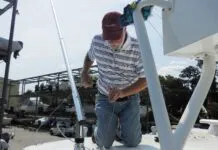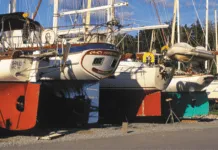The US Coast Guard requires boats to carry a “sound-signaling appliance.” Referred to in the navigation rules only as “whistles,” on small craft these appliances usually take the form of horns (both fixed and handheld) and mouth-blown whistles, although the Coast Guard interpretation is actually more liberal.

Although a sound-signaling appliance is required on all vessels, larger ones—those over 39′ 4″—must meet more exact requirements. Handheld portable horns—whether air-, propellant-, or lung-powered—may be used to fulfill this mandate, and some standard whistles may even fill the bill. What’s the bill? Coast Guard rules state that every boat must carry a device capable of producing a four-second blast audible from 1/2 mile. Handhelds also serve as a backup on larger vessels with permanently installed electric or air horns.
What We Tested
Our last full-blown handheld horn test was published way back in 1990, so we’re overdue. We rounded up an even dozen. Our group included chemical propellant-powered horns, three from Falcon, one of which was rated the winner in our last test, one from Signaltone, and three from Tempo. We also tested three lung-powered horns: one from Attwood, one from Plastimo, and one marketed by West Marine. High-pressure air powers the newest horns on the market. Taylor Made makes both of the models we tested—it markets one itself, and the other through West Marine.
Five of the six chemical-propellant horns use tetrafluoroethane, a high-temperature refrigerant that is purported to have no ill effects on the ozone. These horns have numerous warning labels stressing the possible dangers of this chemical, and the jury is still out on the amount of damage—if any—this chemical does to the ozone layer. The sixth horn, the Falcon FSH, which uses Isobutane, is ozone-safe, but is flammable and presents a fire hazard.
We topped off the field with five whistles, some of which were previously tested in November of 2000. These horns and whistles are all readily available at one or more of the large retail marine-supply houses.
How We Tested
We devised a series of tests to check loudness and range as well as to determine which devices could meet or exceed requirements similar to those defined in the USCG navigation rules.
More than half of the products claim to produce sound at a certain decibel level. Most manufacturers don’t indicate at what distance this measurement was taken, although we found out that it’s usually 1 meter—the distance ABYC (American Boat and Yacht Council) uses in its standard. So we set up our trusty decibel meter at one meter from the business end of each product.
Our second test was designed to see if each device was capable of meeting the Coast Guard’s prolonged blast mandate—four seconds. They all passed. In fact, all of the devices we tested were able to reach 5 seconds. But we noted differences among the horns during their respective prolonged blasts, and we assigned them ratings. Tone, strength of the sound, and other subjective factors were considered. The ratings are poor, fair, good, and excellent. None scored “poor” in this prolonged blast test because, as we mentioned, they all blew for five seconds.
Our third evaluation, range testing, was done on the ocean off Key Largo, FL, under the following conditions: The air temperature was 81 degrees F with the wind blowing a steady 15 knots. We lined up our testers so the wind was nearly a direct crosswind. Yes, these are tough conditions for range testing of sound-producing devices. But they’re real-world conditions.
Our initial plan was to test out to a range of 1 mile, as this was the range claim of a couple of horns, however, this proved unnecessary. We ended our range testing at 3/4 mile because at that distance no device was audible.
Falcon PBSHN
This is a plastic horn threaded onto a metal canister containing 8 oz. of propellant. The chemical propellant is claimed to be ozone-safe and non-flammable. The canister can be replaced. The manufacturer does not specify a dB rating for this horn; our testing at 1 meter produced 124 dB. It easily produced a prolonged blast but despite the manufacturer’s claim wasn’t audible for one mile in our tests.
Bottom Line: Excellent performance, equal to the Signaltone Big Horn, but because it has 2 oz. less propellant and costs a dollar more it’s our second choice among chemical-propellant horns.
Falcon FSH
This is a plastic horn threaded onto a metal canister containing 5.5 oz. of propellant. The chemical propellant is ozone-safe but is extremely flammable. The canister can be replaced. The manufacturer indicates a dB rating of 120 for this horn; our testing at 1 meter produced 123 dB.
This horn malfunctioned on our prolonged blast test, producing barely a whimper. We immediately purchased a new horn from a local marine supply house. This horn also malfunctioned and would not produce much sound. We called the manufacturer. Falcon director of marketing Ken Newman said he couldn’t pinpoint the problem without seeing the horns but deduced that the valves in the canisters were probably at fault. The company sent us a replacement horn for further testing, however, it did not arrive in time for the remaining tests. We continued to use the two horns we already had, hoping one might work for the remainder of the testing. Both worked, but only intermittently. We were able to finish our range testing.
Bottom Line: We had to downrate this horn for two reasons: First, it uses a flammable propellant, which seems unnecessary, given the fact that there are viable alternatives. Why add another pressurized, flammable container to the boat if you can help it? Second, and more to the point, the two samples we bought and tested failed to operate correctly.
Falcon SH3
This is a small plastic horn pressed onto a minute metal canister containing 1.5 oz. of propellant. The chemical propellant claims to be ozone-safe and non-flammable. The canister can be replaced. The manufacturer specifies a dB rating of 112. At 1 meter, it only produced 105 dB. It also strained during the prolonged blast test; the tone began to change at the end of the blast, indicating the duration limit was being reached. This horn is operated by a button on the back, not on the top, like most others, and this was not obvious. The horn seemed awkward to operate with one hand. It performed OK in range testing but ran out of propellant just as testing was completed. Total test time was minimal—around 15 seconds—so this horn isn’t going to do you much good in the fog, where you’ll need to blast it continually.

Bottom Line: We found this horn a bit difficult to operate, and it doesn’t last long enough for us. It would be an adequate dinghy horn or backup.
Signaltone Big Horn
This is a plastic horn threaded onto a metal canister containing 10 oz. of propellant. The chemical propellant claims to be ozone-safe and non-flammable. The canister can be replaced. This horn blew a healthy 124 dB. In our opinion, this horn has the lowest tone—or frequency—of all devices tested. It easily executed the prolonged blast with no tonal falloff, and in range tests performed as well as any horn tested, being clearly audible at 3/4 of a mile. The Signaltone Big Horn did fail to meet its range claim of 1 mile in our testing. Signaltone’s David Murray said that the claim, which is written on the product’s packaging, is a mathematical calculation.
Bottom Line: This powerful horn is our top choice of the chemical-propellant models. It was equal in performance to the Falcon PBSHN but is a buck cheaper.
Taylor Made Ecoblast
This is a plastic horn permanently affixed to an aluminum canister. It is supplied with its own air pump. The power for this horn is supplied by compressed air in the canister, eliminating environmental concerns. The canister is easily refilled with the supplied air pump or can be charged using an air compressor. At 1 meter, it produced a 119 dB blast.
It had a little difficulty with the prolonged blast test. Its tone began to fall off at the 5-second mark, and we could hear its sound weakening. (It did perform well in range testing.) We wish it had a larger canister that required less refilling. It takes about 80 strokes to refill it manually.
Bottom Line: This horn has good range and is environmentally sound. However, it doesn’t do very well at the prolonged blast. In a fog, it would need frequent refilling. It’s also the second most expensive in our test group.
Tempo MH12
This is a chrome-plated metal horn threaded onto a metal canister containing 8 oz. of propellant. The chemical propellant claims to be ozone-safe and non-flammable. The manufacturer does not publish dB ratings for this horn, but it sounded a respectable 119 dB at one meter. This horn easily accomplished the prolonged blast with no tonal fall off and performed on par with the best horns in range testing. The metal horn is heavier than the plastic horns, which makes the whole unit slightly top-heavy. The metal horn will be tougher but more susceptible to pitting and corrosion.
Bottom Line: It performed well, but is a bit pricey. We prefer the Falcon PBSHN or the Signaltone Big Horn.
Tempo AH5
This small chrome-and-plastic horn is threaded onto a metal canister that contains 4.5 oz. of propellant. Like its big brother—the Tempo MH12—it blew 119 dB at one meter. This horn accomplished the prolonged blast with no tonal fall off and performed slightly below the best horns in range testing.
Bottom Line: This horn performed well. It’s expensive, but would perform light-duty service or act as a back-up.
Tempo JR1
This horn is identical to the Tempo AH5 except that it has an even smaller canister, containing only 1.5 oz. of propellant. With the smaller canister this horn produced 115 dB at one meter. It fared just as well in range testing, but ran out of propellant by the end of testing.
Bottom Line: Like AH5, this horn did well in range tests, but is short on propellant. It would serve as a backup or dinghy horn, but the AH5 is a better buy.
West Marine Ecohorn
This is a plastic horn mounted permanently to a plastic air bottle. Taylor Made manufactures this horn for West Marine. The power for this horn is supplied by compressed air. It produced a somewhat feebler sound than did the more powerful horns tested—116dB. It did experience a little trouble during the prolonged blast test, having some tonal falloff. Some difficulty was also experienced getting the horn to accept air and to operate.
Bottom Line: This is an environmentally-friendly horn but falls short of the other compressed-air horn (the Taylor-Made Ecoblast) in range performance and loudness.
Attwood Bellow Signal Horn
This all-plastic manual horn is easy to use and seems well-built. We measured 108 dB at 1 meter. It was easy to blow a prolonged blast, and performance during the range tests was comparable to other manual horns. The only thing we didn’t like about this horn was its peculiar sound. In our opinion, its sounds more like a duck call than a boat whistle.
Bottom Line: The Attwood Bellow Signal Horn performed well in range testing and is slightly less expensive than the Admiral Hornblower. The tonal quality is a bit odd, and it is our second choice of the blow horns.
Plastimo PL16183
This plastic, lung-powered horn requires a certain flow of air to operate properly. Too little air and no sound comes out; too much, and less than the maximum sound is emitted. This horn was the quietest of all horns at 1 meter, hitting only 97 dB. It’s virtually impossible to blow a prolonged blast with one breath—too much airflow is required.
Bottom Line: Not recommended as a primary horn. It would be OK for calling a launch, or on New Year’s Eve.
West Marine Admiral Hornblower
This is an all-plastic, lung-powered horn. It failed to meet its rated loudness of 120 dB but is still the loudest manual horn, reaching 112 dB at one meter. This horn is easy to use, and our tester had no problem maintaining a prolonged blast on a single breath.

Bottom Line: This horn and the Attwood Bellow Signal Horn performed very well. The Attwood is a bit cheaper but we liked the Hornblower sound better.
Sea Dog Line Safety Whistle
The manufacturer of this plastic whistle makes no claim as to its loudness; our tester was able to obtain 102 dB from it. We could not accomplish a prolonged blast with this whistle in one breath—it just takes more air than our tester could muster.
Bottom Line: This whistle performed at the bottom end of the bunch. We can’t recommend it.
Skyblazer Clip-on Vest Whistle and
Orion Marine Safety Whistle
These are identical whistles. (Orion markets Skyblazer products.) The best we could coax out of the Skyblazer was 108 dB. The Orion produced a best of 106, not a perceptible difference between the two.
Bottom Line: Both of these whistles perform acceptably (for whistles, that is) but not as well as the Storm (see below).
Storm Safety Whistle
This oddly shaped plastic whistle lays claim to being the loudest whistle on the market. It was, in fact, the loudest whistle we tested by a few dB. We blew 111 dB at one meter. This whistle is capable of producing a prolonged blast with a single breath and it did perform the best of the five whistles in range testing.
Bottom Line: Our top-rated whistle. It is also the bulkiest—the Storm isn’t something you can slip into a pocket or clip to a PFD and ignore.
Lifesaver #1 Safety Whistle
This plastic whistle claims to be able to produce a whopping 118 dB. We don’t know the distance at which this is supposed to occur, but in our test at one meter it fell far short. Our tester was only able to reach 96 dB. Because of the volume of air required by this whistle, it is difficult to produce a long blast with one breath.
Bottom Line: Aside from its failure to live up to its decibel claims, the prolonged-blast difficulty makes it hard to recommend.
Conclusions
The chemical propellant horns were the top performers in our test 12 years ago—and they still are, with the Signaltone Big Horn and Falcon PBSHN running neck and neck.
One of the first generation of compressed air powered horns, the Taylor Made Ecoblast, is very close to the chemical horns in performance. But its struggle in our prolonged blast test worries us. We’d like to see a larger air supply for this horn. If that happens, the larger Ecoblast would be an attractive, environmentally friendly alternative to the chemical horns.
Our tests didn’t address the cases when it’s necessary to repeat a signal for a long time—in a fog, for example. None of the chemical propellant horns can meet the ABYC standard requirement of repeating a signal cycle over an eight-hour period unless you carry a big inventory of spare canisters. In the case of air-powered horns, you must be willing to pump almost continuously.
Lung-powered horns won’t run out of propellent, so prolonged use is less of an issue. Our top-rated breath-powered horn, the West Marine Admiral Hornblower, and top-rated Storm Safety Whistle, should serve you well.
Also With This Article
Click here to view “Value Guide: Handheld Sound-Producing Devices.”
Contacts — Attwood, 616/897-2251 www.attwoodmarine.com. Falcon Safety Products, Inc.908/707-4900, www.falconsafety.com. Lifesaver #1 Whistle, Cameron Group, 360/650-0047. Orion Safety Products, 800/851-5260, www.orionsignals.com. Plastimo Mfg.UK Ltd., 011 (44) 023 8026 2211; www.plastimousa.com. Signaltone, 231/775-1373, www.fiamm.com. Sea Dog Line, 425/ 259-0194, www.sea-dog.com. Storm Whistle, 877/261-3897, www.stormwhistles.com. Taylor Made, 518/725-0681, www.taylormadegroup.com. Tempo Products Company, 800/321-6301, www.tempoproducts.com. West Marine, 800/BOATING, www.westmarine.com.






































